Peter MALONE
Saturday, 18 September 2021 19:48
Mod Squad
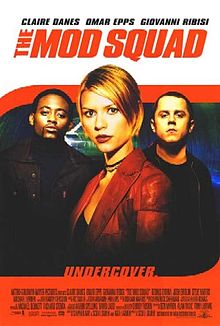
MOD SQUAD
US, 1999, 92 minutes, Colour.
Claire Danes, Giovanni Ribisi, Omar Epps, Dennis Farina, Richard Jenkins.
Directed by Scott Silver.
Mod Squad was a popular television series of the 1960s, capitalising on the spirit of rebellion, youth alienation, the fashions of hair and clothes at the time, language. And three of the young people who had charges against them are commandeered by the police to act as undercover agents. This is not always quite credible, the angry personalities sometimes erupting, even in the middle of undercover work. And some emotional and love problems as well.
Claire Danes had been winning awards on television by this time and had appeared as Juliet in Baz Luhrman’s Romeo + Juliet. She was to have a very successful career, winning many awards for the television series, Homeland. Giovanni Ribisi, however, was to play variations on this kind of role for many years, a man with temperament issues. At one stage, Omar Epps was an emerging star but did not follow through with a successful career. It is a pleasure to see Dennis Farina although he is murdered rather early in the film leaving the excellent actor, Richard Jenkins, as an obvious villain.
The film establishes the three characters, warts and all, and then reveals that they are agents. They squabble amongst themselves, using unorthodox messy methods, mixing in clubs with drug dealers and buyers. However, there is a subplot with double dealings amongst the police, getting rid of the head who had employed the young people, his deputy feigning loyal support but actually in charge of a row operation to get the confiscated drugs and sell them and not above manipulating the three leading to a confrontation at the airport for the transport of the drugs.
This leads to quite a lot of fights, exercises in temperament, and Claire Danes becoming involved with a rather charming individual who turns out to be two-timing her for the drugs, played by young Josh Brolin. Not an effective script and, perhaps, too much immersed in the tone of the 60s as interpreted in the 1990s. Not an entertaining watch.
Published in Movie Reviews
Published in
Movie Reviews
Tagged under
Saturday, 18 September 2021 19:48
Falcon and the Coeds, The
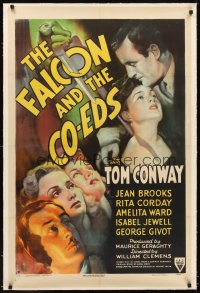
THE FALCON AND THE COEDS
US, 1943, 67 minutes, Black-and-white.
Tom Conway, Jean Brooks, Rita Corday, Isabel Jewell.
Directed by William Clemens.
The Falcon and the Coeds is a further episode in the series of the Falcon, starring Tom Conway, always urbane, slightly sardonic, very reminiscent of his younger brother, George Sanders, from whom he took over the role after Sanders’ death in The Falcon’s Brother.
This time the Falcon is again on holiday but gets caught up in a murder mystery at an exclusive girls’ school on the coast. He is asked to investigate the alleged suicide of one of the teachers at the school, convinced that it was murder, something foretold by the rather fey Margarita, daughter of a distinguished composer who was insane and who has been persuaded that she too is mad.
There are plenty of suspects, from the headmistress who herself is murdered, the psychologist from Europe who married an American to get into the country, the very self-possessed drama teacher, the mousy assistant, as well as some of the girls in the school.
The Falcon interviews everyone, falls foul of the police as usual, is charming and flirtatious, gradually eliminating the suspects despite some of their seemingly underhand behaviour and the audience will have picked that the main candidate left, the jealous and mousy teacher.
The films works well as an easy murder mystery and has some amusing lines, especially those from the Falcon himself, who prefers thinking ‘with a tall glass in hand!’.
The films was directed by William Clemens who directed small-budget supporting features, four Falcon dramas as well as many of the Nancy Drew series.
Published in Movie Reviews
Published in
Movie Reviews
Tagged under
Saturday, 18 September 2021 19:48
Jack and the Beanstalk/ 1953
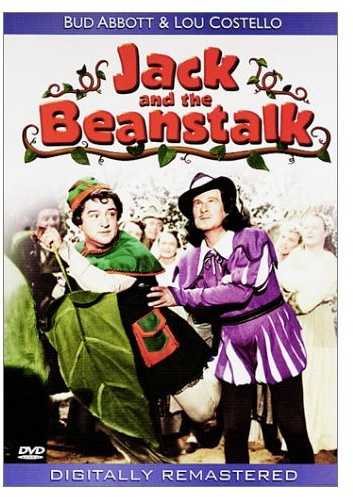
JACK AND THE BEANSTALK
US, 1952, 80 minutes, Colour.
Bud Abbott, Lou Costello.
Directed by Jean Yarborough.
Bud Abbott and Lou Costello had been very successful in pictures during the 1940s, Costello the bumbling fall guy, Abbott the sometimes rather nasty straight guy – not unlike Dean Martin and Jerry Lewis in the structure of their comedies, serious as well as pratfall.
This continued into the 1950s with some films including this one and a move to television.
It must be one of the most modest-budgeted films of the period, relying on just a few sets, especially one for earth at the bottom of the Beanstalk with its crowd of about only 20 extras and with so much of the action taking place. The colour process has also faded somewhat.
The film starts on earth, a very precocious young boy needs a babysitter while his sister goes to a performance and her boyfriend escorts her. At the last minute, the agency is able to provide Abbott and Costello. Lou Costello has a number of pratfalls, deals with the baby whom he thinks is talking whereas it is the precocious young boy. Troublesome pronunciations means that he invites the boy to read Jack and the Beanstalk. And then it comes alive with Lou Costello as an unlikely Jack.
It is a time of famine and Jack sells the family cow for some bean seeds. The country is oppressed by a giant in his own land above the clouds. The bean seeds sprout and a huge beanstalk goes up into the heavens with Jack and his adviser, Mr Dink (Bud Abbott) to accompany him. In the meantime, the Princess has been imprisoned and escapes up the Beanstalk. The prince whom she is intended to marry but has never seen also goes up the stalk. Imprisoned by the giant, they fall in love with each other not knowing who each is – and they sing. As in the story, they get back down the Beanstalk, cut it and the giant crashes to his death. The King arrives and everyone is happy ever after. And all is well at home when the couple arrive.
The film is quite corny, relying on Lou Costello’s presence and bumbling, some awkward lines, some very awkward staging – but, a time-passer for younger audiences.
Published in Movie Reviews
Published in
Movie Reviews
Tagged under
Saturday, 18 September 2021 19:48
She/ 1935
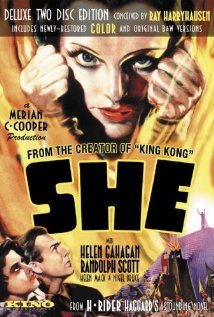
SHE
US, 1935, 90 minutes, Black and white.
Helen Gahagan, Randolph Scott, Helen Mack, Nigel Bruce, Samuel S. Hinds, Jim Thorpe.
Directed by Lancing C. Holden and Irving Pichel.
With Merian C. Cooper having great success with King Kong in 1933, his attention turned to H. Rider Haggard’s writings, especially She. King Solomon’s Mines was to be filmed two years later by Robert Stevenson.
The film has lavish production values, opening quietly in a room in an English mansion and then going to the Arctic with some spectacular snow sequences, most especially an avalanche. Then the travellers pass through some caves and enter an exotic world of fine architecture, lavish accommodation, the overtones of a religion… There are some spectacular scenes in the kingdom, several dances with what seems now rather awkward choreography – and then back home in England.
The film opens with a story about mysterious adventures in the north, a legend about a fire which enabled immortality as well as a gold emblem which has been brought back. Reading a manuscript which has also been brought back, a dying man instructs his nephew and his science associate to travel to find out the truth. In the north, they come across a manager of a trade outpost and his daughter, the man being killed off early because of his greed and the daughter accompanying the travellers and providing a love motif.
However, it is the queen of this kingdom, She, ‘she who must be obeyed’ who controls the rest of the film, thinking that her lover has come back, wanting to trap him, wanting to get rid of the trader’s daughter, protected by her military guard. But, she is seen to be cruel – and in her attempt to preserve her immortality, in fact goes through the fire too many times and crumbles to death.
Quite exotic for 1935.
The film is of historical interest because of some of the cast. This was the only film made by singer Helen Gahagan who married Melvyn Douglas, went into the American Congress for two terms, was mocked by Richard Nixon as being ‘pink’ and was defeated by him in her attempt to be elected to the Senate. Her black outfit as she sat on the throne was the model for that of the wicked queen in Snow White, two years later. Randolph Scott was making routine films, although some Astaire- Rogers musicals, at this time but was eventually to enter into a 25 year run of starring in westerns. Nigel Bruce is the assistant, bungling as always, and soon to become a celebrated Dr Watson to Basil Rathbone’s Sherlock Holmes. Also of interest is the head of the guard played by Native American athlete Jim Thorpe who was to have a biographical film made about him in 1952, Man of Bronze, with Burt Lancaster in the central role.
She has been filmed several times, with the 1966 version starring Ursula Andress in the central role, the best known. And King Solomon’s Mines has been filmed a number of times
1. An exotic entertainment from the 1930s, from the makers of King Kong? The popularity of the novels of H. Rider Haggard, best known as the author of King Solomon’s Mines?
2. The scope of the film, the budget, the cast? The Arctic sets, the avalanche, the kingdom of She? The elaborate interiors? The dances and choreography? The musical school?
3. The plausibility of the plot, the visit to the kingdom of She, the return, the document, the gold emblem? The uncle and his believing the legend, his science associate? The summoning of Leo to England? The explanation of the documents, the legend, the long close ups of the uncle narrating the story, his death? Leo and the expedition to the north?
4. The plausibility of the expedition, Leo and Holly trekking through the snow? Coming to the trader’s house, the old man, the welcome, his reluctance about the trip, the language about the natives, condescending? His daughter and her cooking, keeping the old man? Climbing the crevice, the finding of the frozen snow leopard, the gold? Caution about an avalanche, the trader and his making the vibrations, perishing in the giant avalanche, the others surviving?
5. The decision to go on, finding the caves, going through, their being pursued, the leader of the guard, the explanation of his being able to speak English? the fight? Leo wounded, their carrying him into the kingdom?
6. She, as a personality, her appearance, dignity, the reality of her being immortal? her thinking Leo was John, returned to her? Her command of the kingdom, her love, her cruelty, attitude towards the girl, towards Holly?
7. Leo, character, personality, bringing the girl along, his growing attachment, love? The fight, his being wounded, in the court of She, singling out the men who attacked him, his reaction to her executing one? With She, his bewilderment, wondering whether he was a reincarnation, or had lost all his memories?
8. She, wanting to possess Leo, her persuasion, her harshness, the build-up to the final confrontation, ceremonial, her going into the fire, gradually ageing and dying?
9. Holly and the girl, in captivity, in the court, Leo and his decisions?
10. Happy ending to the saga?
Published in Movie Reviews
Published in
Movie Reviews
Tagged under
Saturday, 18 September 2021 19:48
Innocent/ 2011
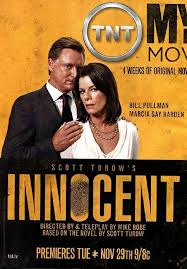
INNOCENT
US,, 2011, 90 minutes, Colour.
Bill Pullman, Marcia Gay Harden, Richard Schiff, Alfred Molina, Marianna Gravena, Collard Harris.
Directed by Mike Robe.
Innocent is based on a novel by celebrated author, Scott Turrow, best known to film audiences for Presumed Innocent, starring Harrison Ford as a lawyer Rusty Sabich. This film takes place 20 years later when Sabich is arrested for the murder of his wife, played by Marcia Gay Harden. Bill Pullman is Sabich, not as commanding a screen presence as Harrison Ford, but able to combine the innocent, the sly, the deceptive. Richard Schiff portrays Tommy Molto, the lawyer who had prosecuted Sabich 20 years earlier.
The film moves backward and forward from the celebration of Sabisch’s 60th birthday and his beginning of an affair with his assistant, then to the morning when he is discovered with the body of his wife and the proceeding court case. The audience is unsure and there are still some surprises when Sabich portrays the situation, sometimes shone in flashback, with what really happened at the time of the death of his wife. Richard Schiff is very good as Molto, being urged on by his assistant, Jimmy Brand (Tahmoh Penniket) who has a vindictive approach to Sabich, wants him in jail and is prepared to stoop to illegal means to effect this.
The film is designed for a television audience and so lacks the scope of Presumed Innocent.
1. An interesting murder mystery and court case?
2. The film had Scott Turrow as consultant, its continuity with Presumed Innocent? Characters, the initial situation, the prosecution, Sabich and his relationship with his wife, her illness and depression? His fidelity and infidelity?
3. The city setting, homes, police officers, legal offices, the court? The musical school?
4. The title, its ambiguity?
5. The situation with Barbara’s death, Rusty and his being in the room for 24 hours, his son’s arrival, the handling of the situation, the presumed suicide? Rusty and his being arrested?
6. Rusty in court, his judgements, the homosexual murderer, the issue of bail, Rusty meeting him in the corridor, threatening him? His change in presuppositions and prejudice? The later testimony of the murder in court against Rusty?
7. Rusty at home, Barbara and her neuroses, change of moods, depression, taking of pills? Love for her son? Nat and Anna at dinner and the tensions?
8. Rusty, with Anna, her prospects, her coming on to him, his succumbing, the affair, the various meetings? The rumours? Rusty breaking of the affair, and her reaction? Anna meeting Rusty, falling in love, explaining to Rusty, going to the home for the dinner? And not telling the truth?
9. Tommy, his work as a lawyer, 20 years earlier, his late family, his hoping for advancement? Jimmy Brand, in the office, urging Tommy to prosecute, insisting, his obsession? His behaviour in court?
10. Stern, friends with Rusty, ill, coming to meet him, defending him, Marta and her assistance? Their work in the court?
11. The witnesses, hearsay, legal officials, medical? Rusty and his ability to answer the questions?
12. The issue of the computer, the message from Barbara? Access to the computer? Rusty and his presumptions about Nat or Anna? The revelation of the truth that Brand had interfered? His justifying himself?
13. The judge, her listening, treatment of the lawyers, the issue of the computer, her wanting the issue settled?
14. Rusty, his plea, impeding justice, the murder charge withdrawn? The reaction of all of his friends? His going to jail?
15. Tommy, talking with Brand, the journalist and her talking about Brand’s drunken claims? Talking with the computer expert? The truth, his acting on it, going to the prison? Rusty released?
16. The truth about Barbara’s tests, her malice towards Rusty? Nat and his support? And? The concealing of the truth from Nat? Appropriate or not?
17. Standard material for this kind of murder mystery and court procedure?
Published in Movie Reviews
Published in
Movie Reviews
Tagged under
Saturday, 18 September 2021 19:48
Yolgnu Boy
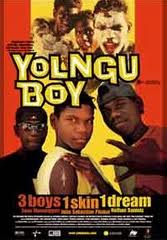
YOLGNU BOY
Australia, 2001, 87 minutes, Colour.
Sean Mungunggurr, John Sebastian Pilakui, Nathan Daniels.
Directed by Steven Johnson.
Yolgnu Boy was made under the auspices of the Yothu Yindi foundation in the Northern Territory and the Australian Children’s Film Foundation. It is filmed in beautiful territory, the Gove Peninsula, Arnhem Land coast. The three central children live on the coast but make their way through the rugged territory to Darwin.
The film takes up contemporary themes for aboriginal teenagers. However, it initially shows them in idyllic situations, young boys, swimming and fishing together, friends, and then undergoing their initiation rites. There is a transition to seeing them in their teenage years, one staying at home and keeping to the traditions, another keen on Australian rules football and wanting to get to Essendon, a third going to prison and being released.
The film shows the realities of 20th-21st-century living for teenagers, in the communities as well is in Darwin. The film does not shy away from portraying petrol sniffing, vandalising stores, the reality of prison. But it also advocates the initiation rites and the importance of these in the boys’ lives, in their transitions from childhood to adolescence, to the significance of the Dreaming, of the symbols, of the importance of the dancing and being in contact with the reality of the traditions.
The three boys portray the aborigines with conviction. They have some potential but are limited by their background, their treatment, conditions in the Northern Territory.
The film also shows the respect for the elders and their taking responsibility in trying to bring up the young men well. There is a glimpse of the Northern Territory police, a small cameo by Jack Thompson to give some cinema credibility to the film.
The film also shows how during the first years of the 21st century, indigenous filmmaking would develop both on screen and on television.
1. An Australian indigenous story? About children? For children? The aboriginal audience, aboriginal children, adults? Other Australians? International audiences?
2. Audience presuppositions, the Dreaming, aborigines and 20th-21st century life, the role of the traditions, in the modern world? Rituals, dancing, initiation ceremonies? Men’s business? The memories of initiation rites and their consequent effect? The 20th-century 21st-century world, modern music, commercialism, vandalism and stealing? Petrol sniffing? Sport? Prison life? The elders and their authority? The musical score?
3. The Northern Territory, its beauty, the Arnhem land coast, the towns and communities, Gove, the contrast with Darwin?
4. The introduction to the boys, the telling this story, their being introduced? The backgrounds, the young age, together, playing, swimming, fishing?
5. The time for initiation, the details of the ceremonies, the painting, the effect? The flashbacks to the ceremonies?
6. The boys in teenage, their lives, together, friendships? Differences? Lorrpu and his being at home? His leadership? Is memories? Millika and football, an easy life? Botz, his father, older, leadership? His sniffing the petrol and its effect? The vandalism and the exuberance of stealing? His carelessness with the fire, the burns, the injuries, hospital?
7. Botz, coming out, the injury to his arm, the danger for the police?
8. Lorrpu and his decision to go to Darwin, finding the boat, it capsizing, taking the radio and the modern music, the trip, the rowing, the stingray and its pulling the boat, seeing the turtle, capturing the turtle, the food? The difficulties, their clashes, the different visions for the future? Hopes? Hunting and painting, traversing the land?
9. The authorities, the white police, Jack Thompson in a cameo role? The aboriginal elders, the responsibilities, there guarantees, the search? The helicopter?
10. The young girl, flirting with Liverpool, leaving on the plane, the promise of the visit, his going to the school and her reaction?
11. Getting to Darwin, eating in the cafes, the clashes, new clothes, shopping? Botz going to find his father, his father not aware of his son, beating the
cigarette? Botz and his going to the wharf, sniffing the petrol, his death? The others finding him, the effect, grief? The elders and the funeral?
12. Aboriginal stories, the boys, their potential, conditions for life, favours and successes? The future?
Published in Movie Reviews
Published in
Movie Reviews
Tagged under
Saturday, 18 September 2021 19:48
XMen
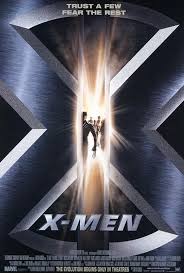
X-MEN
US, 2000, 104 minutes, Colour.
Patrick Stewart, Ian Mc Kellen, Hugh Jackman, Halle Berry, Famke Janssen, James Marsden, Anna Paquin, Tyler Mane, Ray Park, Bruce Davison, Shawn Ashmore.
Directed by Bryan Singer.
X- Men was very successful on its first release in 2000. It emerged when comic books were becoming very popular on-screen. In fact, it led to two sequels as well as a film about the origins of the X- Men, two Wolverine films as well as X- Men, Days of Future Past.
Patrick Stewart became the icon of Professor Charles Xavier, head of the school for mutants. Classical stage actor, he had become very popular as Captain Picard in the Star Trek series. Ian Mc Kellen, also a professional stage actor, had made many films, including Apt Pupil, for director Bryan Singer. With his role as Magneto, followed by his six films as Gandalf in The Lord of the Rings as well as The Hobbit films, he became an international star.
Many actors were considered for the role of Wolverine but it was given to Hugh Jackman who had appeared in some Australian films but was best known for his musical talent in Beauty and the Beast, Sunset Boulevard and, in the West End, Oklahoma. He received very good reviews and appeared as Wolverine in all the subsequent films including the two about his character. Halle Berry also made an impact as Storm, and James Marsden as Cyclops. Anna Paquin was to appear in the subsequent films as Rogue as did Famke Janssen as Jean.
The stories, created in the 1960 by Stan Lee and James Kirby, were imaginative in the creation of the mutants, their powers and their exercise of their powers. In this story, there is hostility towards mutants, especially in the politician played by Bruce Davison. However, Magneto captures him, tortures him and persuades him to change his attitude. In the meantime, Magneto’s allies were to disrupt an international meeting and make away with the delegates.
Director Bryan Singer had first made a number of independent films but moved more into the mainstream with Apt Pupil and this film. He made Superman Returns, Valkyrie as well as further X- Men films.
1. Acclaim at its first release, favourable reviews? Popularity at the box-office? And the now-long series of films which derive from this original.
2. 2000 and the popularity of graphic comics? The film versions? This series in print in the 1960s, the characters, the issues?
3. The basic premise of the film, the existence of the mutants? The characters, their roles? Discovering the mutation, fears? The possibility of mutants coexisting with humans?
4. The strong cast, their pinpointing their characters, establishing characters for the further films?
5. The range of settings, rugged country, suburbs, New York City, the Statue of Liberty, Professor Xavier’s School? The musical score?
6. The opening, the introduction to Rogue, at home, her discovering her mutation, unable to be touched? Her fears, hurting others? Her escaping from home, the encounter with Wolverine, their travelling together, a fascination with him and his claws, his going into action to defend them? Coming to Professor Xavier school?
7. Introduction to Wolverine, Hugh Jackman beginning his long series as Wolverine? Appearance, personality? The growing development of information about him during the series? His going into action, the encounter with Rogue, the fights, claws, the pain as they came out and withdrew? His independence, yet his concern for Rogue?
8. The introduction to Professor Xavier and Magneto? Their past, the war, the Holocaust? Suffering, seeing them as young, the effect (later taken up in X-Men? Origins) and the choosing of the dark side by Eric, his mutation, magnetism, Magneto? Charles and his choosing the heroic side, his injuries, his becoming a professor, his school? Seeing him in action in the school, his support of the students?
9. The introduction to the mutants, Storm, her face, her appearance, her clothes, capacity for creating storms? Cyclops, masking his eyes, the intensity of his gaze, constructive and destructive? His personality?
10. The member of Congress, his speeches, denouncing the mutants, rallying people against them, the encounter with Magneto? Magneto, taking him, subjecting him to torture and brainwashing? His going to the meeting, his speeches? His apology, and his supporting mutants? His surviving the ordeal with Magneto?
11. Jean, her speech about the mutants, interrogated by the Congressman, her own powers? Who work at the school? The encounter with Wolverine, helping him with his injuries? The bond between them?
12. Ordinary life at the school, Professor Xavier, the various mutants, the youngsters who would become important in the success of films?
13. The confrontation between the older Xavier and Magneto? Love-hate?
14. The mission, Magneto with Rogue, at the Statue of Liberty, her imprisonment and fear? Magneto and his wanting to touch her and transformer?
15. The meeting, the world leaders, the issue of dominance, the issue of the mutants? The scenes of the meetings?
16. Magneto and his associates, Mystique, Sabretooth, the Toad? In action, their fights, the techniques? Mystique and her transformations?
17. Storm and creating the storm, Cyclops and his using his eyes? Jean and levitation? Wolverine, his fights, capture, breaking free, Mystique becoming Wolverine, his seeming to fight himself? His sense of the enemy present? Mystique becoming Storm? The confrontation and fights?
18. Magneto taken, imprisoned and isolated by Professor Xavier? Still having ambitions to conquer? The rest of the mutants going back to the school and a sense of peace? Wolverine and his decision to leave?
19. Audiences ready for the sequels?
Published in Movie Reviews
Published in
Movie Reviews
Tagged under
Saturday, 18 September 2021 19:48
Grace is Gone
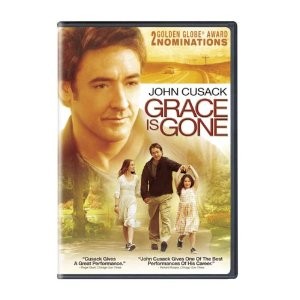
GRACE IS GONE
US, 2007, 85 minutes,Colour.
John Cusack, Alessandro Nivola, Shellan O’Keefe?, Grace Bednarsszyk, Marisa Tomei.
Directed by James G Strouse.
Grace is Gone is a brief drama, a family tragedy, a story of the wars in Iraq and Afghanistan. Grace is a wife and mother who serves in the military in the Middle East. Her husband, Stan (John Cusack) trying to serve his country in the military but was rejected by for poor eyesight. He is at home, with a warehouse job, looking after his two daughters at school and home. Then the news comes that his wife has been killed in action.
The film traces Stan’s psychological response to his wife’s death and his inability to tell his daughters the truth. He takes them out of school, takes them on a trip to an entertainment park in Florida, pausing to see his mother but finds his brother John (Alessandro Nivola). His views are the opposite of his rather traditional and conservative brother.
The film focuses on the two girls, a rather wise 12-year-old who knows that there is something wrong, and a little playful eight-year-old. Stan’s behaviour is erratic, and ultimately he has to tell his children the truth. This enables them to face the future.
The two girls are credible, but John Cusack’s performance seems somewhat unbelievable, especially in his trying to deal with telling the truth to his daughters.
1. The impact of the film, a piece of Americana, the beginning of the 21st century, the overseas wars for the United States, military action in Iraq, personnel trapped in Iraq, deaths, the consequences for families?
2. The title, information, tone?
3. The basic situation, Stan and his work, his work ethic, Grace as mother, wife, serving her country? The impact on the family, the little girl and the silence and the time when mother and daughters would be thinking of each other? The news of her death?
4. Stan, at work, his work ethic and encouraging the workers, wearing glasses, sight difficulties? At home, the children at school, dealing with homework, their clashes, meals?
5. The girls, their ages, planning and fighting, typical of their age? One serious, one playful?
6. The military at the door, delivering the news, Stan and his unwillingness to hear, their coming in, offering help? Stan and his bewilderment, grief?
7. The girls, noticing something different? Puzzled? Stan deciding to take them for a trip, to the entertainment park? The girls’ different reactions? Heidi in the car, the need to ring school, Heidi doing this and puzzled by this sympathetic responses?
8. Travelling in the car, songs, fights, jokes? Going to the motel, Heidi going outside, the boy, the cigarette, Stan and his heavy reaction? At the pool, swimming, the boy, his mother?
9. The visit to home, the girls going in, Stan searching for entry, finding John? John, the younger brother, his character, his appearance, scruffy, no job, his political views, the opposite to those of Stan? His taking the girls out? The phone call, hearing the news about Grace’s death? His not telling the girls? Stan leaving?
10. Staying in the motel, Heidi wanting to stay outside?
11. The entertainment park, the happy day, all the rides, ready to go home?
12. His stopping by the sea, telling them, the sound going down and the audience just watching the telling and the reactions? The grief?
13. Going home, facing the future, ready to face the future or not?
Published in Movie Reviews
Published in
Movie Reviews
Tagged under
Saturday, 18 September 2021 19:48
Falcon's Brother, The
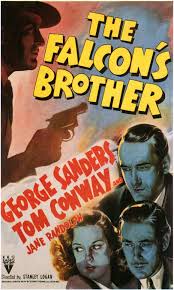
THE FALCON’S BROTHER
US, 1942, 67 minutes, Black and white.
George Sanders, Tom Conway, Jane Randolph, Keye Luke.
Directed by Stanley Logan.
George Sanders had appeared as both The Saint and the Falcon. He considers these films as the nadir of his career though they kept in popular onscreen. He was making such films as Rebecca and Foreign Correspondent at this time. This was to be his last film as The Falcon. He was co-partnered with his actual brother, Tom Conway, who took on the role of The Falcon for another nine films. The two brothers looked rather alike, sounded rather alike, and the transition from one brother to the other for The Falcon was easy.
Sanders as The Falcon is a bit more happy-go-lucky than as Simon Templar, though he still has a flirtatious eye on the women. In fact, the two characters are not very dissimilar. What was required was an urbane screen presence, gentlemanly behaviour, some wit and some ability to solve difficult cases.
Here there is a report of The Falcon’s brother and his dying on a voyage from Latin America. Though the Falcon identifies the dead man as his brother, he is not. And with his faithful assistant, servant, Sancho Panza type character, Lefty, he goes in pursuit of the truth.
His quest leads him to a fashion show, dress designer, the editor of a fashion magazine, a pair of dancers from Latin America, a designer who was in the United States illegally. Plenty of suspects. However, the woman in contact with the brother is soon murdered. There are also the local police investigating – somewhat bumbling, reaching conclusions far too soon.
Suddenly The Falcon is injured in a hit run and his brother has to take his place, the dramatic transition for the series. There is also an eager fashion journalist who wants something more in her career and tags along for the investigation. The brother does most of the investigation but once The Falcon recovers, he is also in on the resolution of the mystery.
The dress designer is what she says. The Hispanic dancers are not what they seem but are involved in government undercover work. The illegal immigrant is also murdered – which leaves the fashion magazine editor as the main suspect. Which he uses, using the covers of his magazine to indicate times and places for anti-American activity. In this case, a diplomat seeking peace is to be assassinated – and, unexpectedly, but like screenplays for soap opera in series in later decades, The Falcon stops the bullet to save the ambassador and now can be written out. Which, of course, leaves the series open for Tom Conway as the new The Falcon.
Published in Movie Reviews
Published in
Movie Reviews
Tagged under
Saturday, 18 September 2021 19:48
By the Light of the Silvery Moon
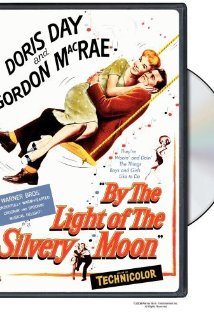
BY THE LIGHT OF THE SILVERY MOON
US, 1953, 101 minutes, Colour.
Doris Day, Gordon Mc Rae, Leon Ames, Rosemary De Camp, Mary Wickes, Billy Gray.
Directed by David Butler.
By the Light of the Silvery Moon is one of the many Doris Day- Gordon Mc Rae musicals from Warner Brothers in the 1950s, Tea for Two and the first film in the Penrod series from Booth Tarkington’s novels, On Moonlight Bay (1951).
This film takes up the story of Marjorie, the tomboy of her town in Indiana. And Doris Day fits the bill completely with her personality, her on-screen verve, her singing, dancing, comic touches. Gordon Mc Rae is Bill, returning from his experiences in World War One and uncertain whether he should marry Marjorie immediately or get a job and build up a nest egg. Leon Ames and Rosemary De Camp are once again the parents. And, for good measure and comic measure, Mary Wickes is back as the housekeeper, Stella. Billy Gray appears also as the young brother, full of mischief.
The film probably offers the ideal image of white American middle class families in the United States of the 1950s. However, the setting is 1918-1919, once again showing the apple pie, picket fence, cheery American family in a cheery American town – although many of the inhabitants are eager for spreading gossip!
There is the title song as well as many others and the film was directed by David Butler, director of many of these films.
1. The appeal of this kind of film in the 1950s, Doris Day and Gordon Mc Rae as very popular, in films, singing, records?
2. The post-World War I period? Soldiers returning from the war – though presented very cheerfully, singing My Hometown in the train, received well on return? Getting jobs? Settling in? Marriages? The Indiana setting, Middle America? A conventional white America?
3. Doris Day is Marjorie, pert, verve, 18, singing and dancing, comic songs, loving her parents, her brother, Stella and her support? Fixing cars and her father’s reaction? Her hopes to marry Bill on his return? Bill wanting to put off the wedding, a disappointment, agreeing? Going to the dances, the meals? Her upset at the misinterpretation of her father’s behaviour and letter? Thinking the worst? Protecting her mother? Asking her brother to burn the letter? Feeling unable to marry Bill, putting him off when he was ready? The resolution of the problem, the bad judgements, Bill and his disguise, skating, the happy resolution of the marriage problem?
4. Gordon Mc Rae as Bill, pleasant leading man, the war, singing in the train, meeting Marjorie again, his hesitation, wanting to reflect on his experiences in the wider world? Marjorie and his putting off the wedding, his announcements, her reactions? The car home, the breakdown, her fixing the car? His walking? Apologies? His getting the job, the visits to the house, willing to marry, Marjorie and her reaction, his leaving, returning disguised, the happy ending?
5. The ideal parents, the father, his job at the bank, mother at home, 20 years married, happy memories, their children, Stella? The father and his helping the actress, the letter and all the misunderstandings? The gossip? His being upset at the gossip? The happy skating ending?
6. Stella, all her introductions, the comic tone, Mary Wickes and her comedy? Her work in the house, helping Marjorie, the dress, the issue of the letter, the final happy ending?
7. The son, mischief, paw prints and the dog, piano lessons, loving his parents, cheeky, the issue of the letter and his burning it,his imagining the play, the actress is the villain, going to see her, his peculiar behaviour? Bill stopping him burn the letter? His going to the station, the telegram to Bill, the stationmaster, his gossiping wife, all the phone calls, coming back to her? And the gossips at the dance?
8. The music teacher, his attentions to Marjorie, at the house, the gifts and the chocolate, his song and plan yet, his being with the family, the outing, wanting to dance with Marjorie, the fight with Bill – and his winning! The finale at the dance, his playing the piano, not winning Marjorie?
9. The actress, consulting the father, the misunderstanding of the letter, her encounter with the boy, the happy resolution?
10. The film as something of an Americana chocolate box?
Published in Movie Reviews
Published in
Movie Reviews
Tagged under